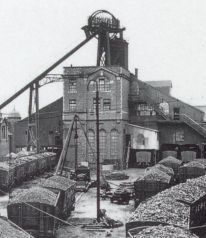
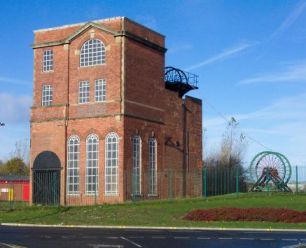
The Tokens, Tickets & Passes of the Harton Coal Company: Part I - An Introduction to the Tickets of the Company's Private Passenger Railway.
In this, the first of three articles related to the Harton Coal Company of South Shields, a brief history of the company's operations is outlined plus one of the many memorabilia legacies that this once great coal mining giant has bequeathed us. In this article we are introduced to the vast number of interesting and colourful card and paper tickets which were used on the company's private passenger railway between South Shields and Whitburn Colliery. These tickets are numerous and a large number of them have survived into modern times making them the focus of a specialised collecting theme in their own right. The various related metallic railway passes and tokens issued in the name of the Harton Coal Company will be dealt with separately in Part II of this series of three articles.
The Harton Coal Company (H.C.C.) was formed in 1842 and purchased a pit in South Shields called St. Hilda. It also started construction on a second pit in the village of Harton. Harton Colliery started producing coal in 1844 and with the company's third pit, Boldon opening in 1869, the three were capable of mining all the inland coal within the company's lease.


Then & Now - The pit head at St. Hilda Colliery in c.1930 (left) and 2003 (right).
In 1874 the coal company turned its attention to the vast seams of coal, which lay offshore, for this purpose it set up two companies, one was the Harton & Hilda Coal Co. to manage the established mines at Harton, St Hilda and Boldon. The second, the Whitburn Coal Co. was formed to construct and develop the new coastal mines (i.e. Whitburn and Benthouse/Westoe Collieries although the latter mine didn't come into production until well into the twentieth century). Problems were soon encountered during the sinking of the shaft at Whitburn, which amounted to immense quantities of water ingress and quicksand was also present. A drift was constructed seawards to enable the water to flow out of the nearby cliffs and into the sea. The company called in expert engineers from Belgium and by using cast iron tubing and three large pumps they were able to get over the problem. Apart from the flooding the Whitburn Coal Company's other difficulty was the transportation of coal from this remote part of the coast down to the River Tyne. The obvious solution would have been to construct a railway line westward to join the North Eastern Railway's line, which served Harton Colliery. However a natural barrier known as the Cleadon Hills forced the railway engineers to go northwards along the coast to the village of Westoe and from there the line curved inland to join the North Eastern Railway.
Before the pit was built, Marsden was a very small village made up of farms, isolated cottages and a lighthouse at Souter Point, there was a small amount of industry in the area, which was that of limestone quarrying. The Whitburn Coal Co. decided to purchase five quarries in all, and went on to develop two of them known as the Lighthouse Quarries. The quarries lay next to the new railway and were found to have large reserves, which were to provide traffic for the railway.
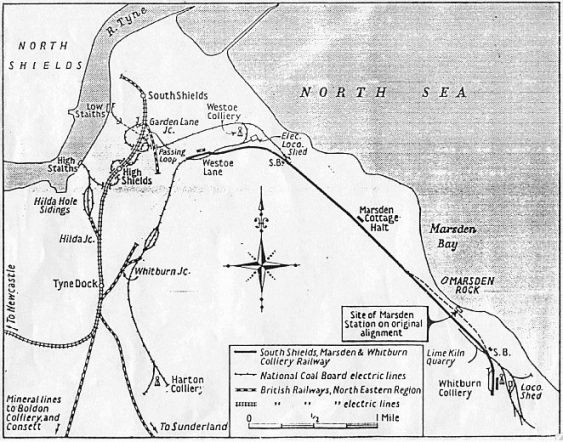
A map showing the extent of the Harton Coal Company's mining empire plus the routes of both its private mineral and passenger (i.e. the SS,M&WCR) railway lines.
With the building of the mine and the expansion of the limestone quarries an extra workforce was required. To cater for the influx of new workers the Whitburn Coal Co. built a new village at Marsden. The village was built between the Lighthouse Quarries and Whitburn Colliery and could cater for up to 700 people, having a post office/general store, chapel, recreation field and later a school and church were added. The village was situated on the cliff top therefore open to all the elements and with its isolated position many of the Whitburn miners preferred to live in South Shields.
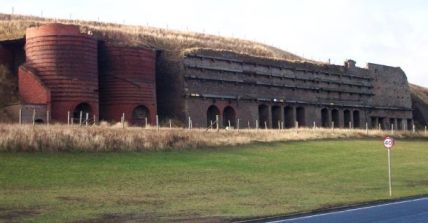
The remains of the Whitburn Coal Co.'s massive battery of lime kilns just north of the now levelled site of Marsden Village on the line of the old South Shields to Whitburn Colliery railway line. The seven original stone and steel re-enforced kilns were build c.1880s while the two red brick shaft kilns were added in 1895.
Construction of the railway was well under way when in late November/early December 1878 two agreements vital to its completion were laid before the South Shields Corporation. After many debates the Whitburn Coal Co. was given permission to build the final section of the railway through South Shields. The Whitburn Colliery and its railway (locally known as the Marsden Railway) was finally opened to mineral traffic in May 1879.The colliery and the railway got off to a very slow start as the pit was not ready to start full scale operations. By late 1881 the pits annual production was less than 10,000 tons. It was limestone that initially made up most of the mineral traffic on the railway.
It is assumed that the workers involved in the construction of and working of the mine and quarries must have travelled to and from South Shields by train every day as at this time there was no direct road link between South Shields and Marsden. The earliest reference to passengers using the line was in 1885 when Whitburn Colliery solicitors wrote to the Board of Trade asking for guidance as to what was required to enable them to carry passengers. After much correspondence and inspection visits by the Board of Trade, they sanctioned the opening of the line between South Shields and Marsden (a distance of 2¾ miles) on the 14th February 1888. The first passenger trains began running on the 19th March 1888, nine years after the railway first opened. The timetable from 1890 lists the following services:
Weekdays - 8 departures from South Shields and 7 from Marsden.
Saturdays - 7 departures from South Shields and 6 from Marsden.
Sundays - 6 departures from South Shields and the same from Marsden.
Each service was allowed 10 minutes to cover the 2¾ miles between South Shields and Marsden. The early timetables only listed services that were operated for use by the general public. The mine and quarry workers had separate trains and these services ran beyond Marsden to a private platform at the colliery itself. No information is currently available regarding the details of the type or appearance of the early passenger tickets used on the railway at this time. However, in 1968 it was reported in one railway history journal that at least one ticket for use on this line was in the collection of the York Railway Museum. This ticket, which was reportedly issued in the name of the Whitburn Coal Company, unfortunately can no longer be traced by the staff of the National Railway Museum.
After a slow start Whitburn Colliery began to produce a respectable amount of coal but geological and financial problems stifled the companies true potential. In 1891 The Harton Coal Co. decided to dissolve both The Whitburn Coal Co. and The Harton & Hilda Coal Co., and run all its mines as a single company.
The passenger services that had in the beginning been operated from the South Shields end of the line were in 1895 run from the Marsden end, thus allowing South Shields to be cleared of stabling carriages. This made a lot more room for the mineral movements that by this time were becoming far more frequent. During the same year a start was made on rebuilding Whitburn Colliery, as part of the rebuilding work the miners platform was moved from the eastern side of the mine to a site alongside the winding gear.
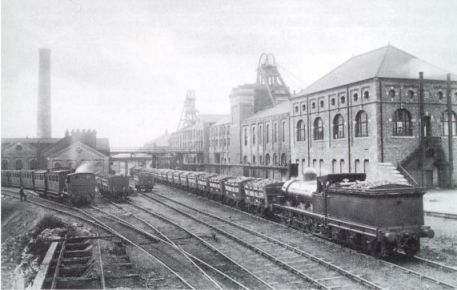
Whitburn Colliery c.1900 - The "Rattler" can be seen in the far left of the picture along side the colliery platform (this view from the north looking south).
The timetable for 1900 shows a marked change in train patterns from that of 1890. The departures were as follows:
Weekdays - 6 departures from Marsden and the same from South Shields.
Saturdays - 8 departures from Marsden and the same from South Shields.
Sundays - 9 departures from Marsden and the same from South Shields.
Weekend services were increased due to the miners and their families making more visits to South Shields and holidaymakers making journeys to Marsden to visit the local beauty spot of Marsden Bay. The Harton Coal Co. started upgrading the railway in 1900. They completely rebuilt the station at South Shields and renamed it Westoe Lane. The train tickets issued from the station were never changed to Westoe Lane they all refer to South Shields. They also built a very small halt called Marsden Cottage approximately 1¾ miles from Westoe Lane to cater for the population of new housing estates. They even renamed the railway "The South Shields, Marsden and Whitburn Colliery Railway" (SS,M&WCR) but the locals still referred to it as the "Marsden Railway". The fares in place at this time were:
First class adult single 9d
First class adult return 1s 3d
Third class adult single 4d
Third class adult return 6d
A criticism was levelled at the company that the fares were far to dear for such a short journey.
The Harton Coal Co. where ever possible always bought new wagons for its mineral railway but coaching stock was strictly bought secondhand. The coaches that were delivered to the railway were virtually life expired and the public must have found them most uncomfortable. The riding qualities of the carriages gained some notoriety and the service was given the nickname "The Marsden Rattler" which remained with it until the service ended.
The Marsden Rattler c.1950
The early part of the 20th century saw the Harton Coal Co.'s empire at its height with a workforce of approximately 10,000. It embarked on a modernisation program of its colliery, quarries and railway system. The majority of its investment in the railway system was centred around the electrification of its mineral railway from its collieries to the newly built staiths on the River Tyne. The electrification was worked off overhead wire at 550 volts DC and considered to be "state of the art". The electric locomotives ran from two set of staiths on the Tyne to a new exchange sidings at the "Bents" area where the change over from steam to electric locomotives could take place.
As previously mentioned South Shields station was renamed Westoe Lane, however this could cause confusion for a stranger to the town because by 1913 Westoe Lane had become Westoe Road and the station itself was always situated in a side street called Mendelssohn Road! Also by 1913 each train was being used by both the public and the workmen, although the train guard would escort the public to a different section of the train than the one used by the miners. The first stop out of South Shields was at Marsden Cottage but this stop was by request only if passengers wished to alight here, they would tell the guard at Westoe Lane and he would inform the driver that a stop was required. The next stop was Marsden and finally onto Whitburn Colliery station, which like all the other stations on the line only consisted of a single platform.
The railway settled into a routine after 1913. Coal production at Whitburn was impressive and output was also good at the Lighthouse Quarries. Profits from Whitburn alone for 1913 were said to be in the region of £432,000.The takings for the railway in that year amounted to just £264, however this more than covered the running costs, even though the company had reduced its First class fares from 9d to 6d single and from 1s 3d to 9d return. The range of tickets (standard Edmondson card type, nominally 57 mm by 31 mm in size) on sale at this time were as follows:
First Class Adult Single 6d
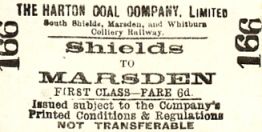
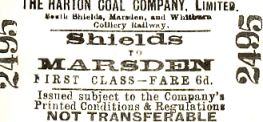
Ticket Nos. 1A & 1B - First class adult singles from South Shields to Marsden. Note minor printing differences between types. Reverses are blank other than for a central vertical blue bar.
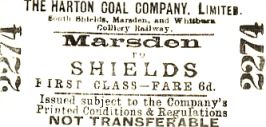
Ticket No. 2 - First class adult's single from Marsden to South Shields. Reverses are blank other than for a central vertical blue bar.
First Class Adult Return 9d
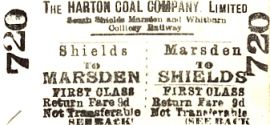
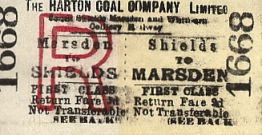
Ticket Nos. 3 & 4 - First Class adult singles from South Shields to Marsden plus Marsden to South Shields. Reverse legends (in duplicate on each half of ticket) state that issue of the tickets is subject to the company conditions and regulations and that the tickets are not transferable.
First Class Child Single 3d
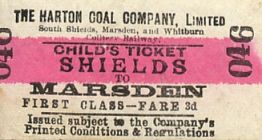
Ticket No. 5 - Child's first class single from South Shields to Marsden. The reverse is blank.
First Class Child Return 4.5d
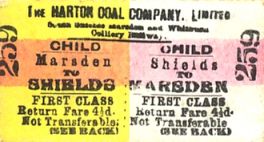
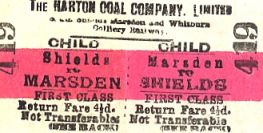
Ticket Nos. 6 & 7 - Child's first class returns from Marsden to South Shields and South Shields to Marsden. The reverses are blank.
Third Class Adult Single 4d
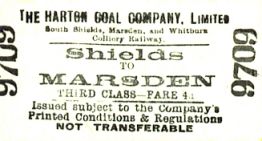
Ticket Nos. 8A & 9 - Adult's third class singles from South Shields to Marsden and Marsden to South Shields. The reverses are blank.
Third Class Adult Return 6d
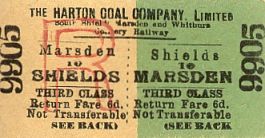
Ticket No. 10 - Adult's third class return from Marsden to South Shields. Reverse legends (in duplicate on each half of ticket) state that issue of the tickets is subject to the company conditions and regulations and that the tickets are not transferable.
Third Class Child Single 2d
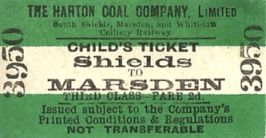
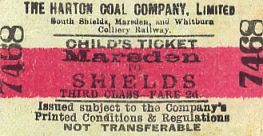
Ticket Nos. 11A & 12 - Child's third class singles from South Shields to Marsden and Marsden to South Shields. Reverses are blank.
Third Class Child Return 3d
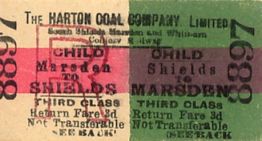
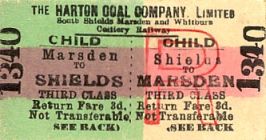
Ticket Nos. 13A & 13B - Child's third class returns from Marsden to South Shields. Reverse legends (in duplicate on each half of ticket) states that issue of these tickets is subject to the company conditions and regulations and that the tickets are not transferable.
Single to Marsden Cottage 2d (apparently irrespective of class)
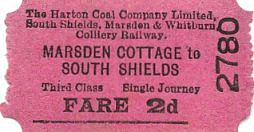
Ticket No. 14 - Third class single from Marsden Cottage to South Shields. The reverse sides of these paper real tickets are blank. Actual size 53 mm by 28 mm.
Special meeting tickets for Sunday D.M.A. Whitburn Lodge meetings 3d
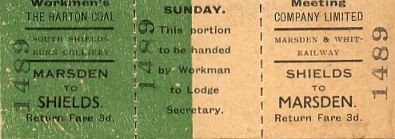
Ticket No. 15 - Workman's Sunday D.M.A. Lodge Meeting return ticket from Marsden to South Shields. Reverse legends (in duplicate on each end section of the ticket) states that the issue of these tickets is subject to the company conditions and regulations and that the tickets are only for use by workmen travelling to and from Sunday meetings at the Whitburn Miners Hall. Actual size 86 mm by 31 mm.
School child's weekly tickets 5 for 7.5d (5 separate tickets marked Monday to Friday)
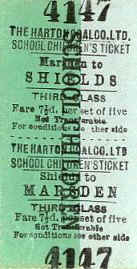
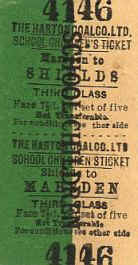
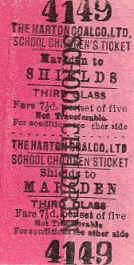
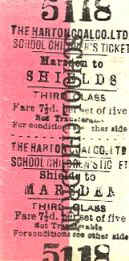
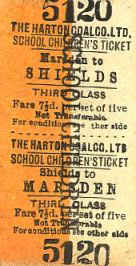
Ticket Nos. 16 to 20 - A weekly set of School Children's third class returns from Marsden to South Shields. Reverse legends (in duplicate on each half of ticket) state that issue of the tickets is subject to the company conditions and regulations and that the tickets are only for use by children travelling to and from school. In addition in large red ink letters on both halves of the ticket reverses are the abbreviated initials for the particular day of the week for which each ticket was valid, i.e. "M", "TU", "W", "TH" and "F".
Single tickets for the carriage of dogs 3d
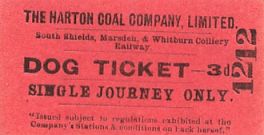
Ticket No. 21 - A single journey dog ticket. The legend on the reverse of these tickets states that "The Company are not and will not be common carriers of dogs, nor will they be responsible for any damage whatever".
Single tickets for the carriage of Bicycles or Prams - when accompanied 2d , when un-accompanied 4d
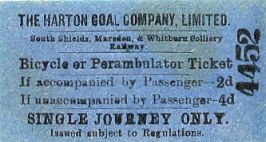
Ticket No. 22 - A single journey Bicycle or Perambulator ticket. The reverse is blank.
Workman's weekly tickets 6 for 1s 6d (6 separate tickets marked Monday to Saturday)
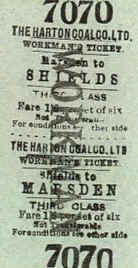
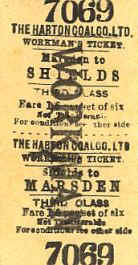
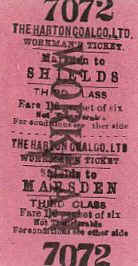
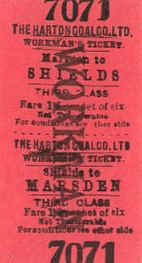
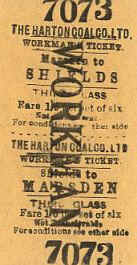
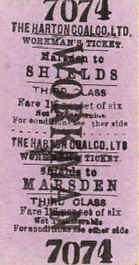
Ticket Nos. 23 to 28 - A weekly set of Workmen's third class returns from South Shields to Marsden. Reverse legends (in duplicate on each half of ticket) state that issue of the tickets is subject to the company conditions and regulations and that the tickets are only for use by workmen travelling to and from work. In addition in large red ink letters on both halves of the ticket reverses are the abbreviated initials for the particular day of the week for which each ticket was valid, i.e. "M", "TU", "W", "TH", "F" and "S". It is understood that from the 1940s onwards H.C.C. / N.C.B. workmen travelled free of charge when using the train service to commute to and from work.
The passenger timetable for 1913 shows an increased service compared to 1900 and it was also geared much more to the shift change times at the pit. The departures were as follows:
Weekdays - 11 departures from Marsden and the same from South Shields.
Saturdays - 12 departures from Marsden and the same from South Shields.
Sundays - 9 departures from Marsden
The Saturday departures of 12 trains only ran when the pit was open (alternate Saturdays), when it was "Pay Saturday" an 11 train service was operated.
In June 1923 plans were laid before South Shields Corporation that would change the face of the railway. At the time there was no direct road link between South Shields and Whitburn and with road traffic on the increase the Corporation decided to build a new road. It was clear that the main obstacle to the road-building program would be the railway and after much debate and compensation being offered, the Harton Coal Co. wrote to the Corporation telling them that it had decided to close Marsden station and build a new terminus at Whitburn colliery. During the construction of the road it was decided to upgrade it to a trunk road, meaning a lot more costs were incurred and in 1927 it actually bankrupted the Corporation but with a loan from the Government work recommenced in 1928. The coast road finally opened in November 1928 at a cost of £152,000 and a small part of this went to the Harton Coal Co. to pay for its new terminal at Whitburn Colliery.
The new station was in fact an upgrade of the miners' platform. More confusion was caused to the casual traveller because having bought a ticket to Marsden they arrived at their destination to see the station name boards bearing the name of Whitburn Colliery. This situation continued until the closure of the station, a passenger would purchase a ticket from South Shields to Marsden and actually board the train at Westoe Lane and alight at Whitburn Colliery.
The public service now ran 3¼ miles to the new terminus compared to 2 ¾ miles to the old one at Marsden. The train was now allowed 12 minutes for the journey rather than the original 10 minutes.
By 1930 passenger traffic was minimal due to the introduction of the Corporation Bus service that was making good use of the new coast road. At one time the railway was covering its costs but by now it was turning into no more than a local curiosity. The only regular Saturday passengers turned out to be mothers with prams because they had great difficulty in getting prams onto the buses. The public regarded the use of the train as something of a last resort and it seemed inevitable that the service would finish now that the new road had opened, but to the miners the service was vital. A total of over 3000 men worked at the pit and many of these men lived in South Shields and relied on the railway to get them to and from work. The railway was itself very busy moving minerals, but with the advent of the bus and later the trolleybus service the passenger side of the operations were in decline. Ironically during World War II the Ministry of War sealed off the seafront and coast road as a defensive measure, which meant that the "Rattler" continued to provide a full passenger service and in fact provided more trains than it had ever done before. The departures were as follows:
Weekdays - 16 departures from Marsden and the same from South Shields.
Saturdays - 8 departures from Marsden and the same from South Shields.
Sundays - 8 departures from Marsden and the same from South Shields.
After the war the Harton Coal Co. disappeared at midnight on 31st December 1946 and became part of the National Coal Board, this meant that the former South Shields, Marsden and Whitburn Colliery Railway was the only nationalised public railway in the country. From 1947 onwards station staff were instructed to cross out the name of the Harton Coal Co. and write N.C.B. on each ticket they sold.

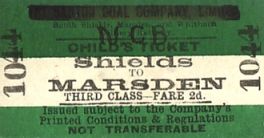
Ticket Nos. 8B & 11B - Examples of two types of H.C.C. tickets which have been officially modified in pen and ink after 1947, re-naming the line owners and ticket issuers as the National Coal Board (N.C.B.).
Eventually re-printed tickets in the name of the N.C.B. were issued.
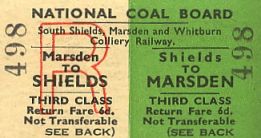
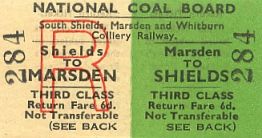
Ticket Nos. 29 & 30 - Adult's third class returns from Marsden to South Shields and South Shields to Marsden both issued post 1947 in the name of the National Coal Board (N.C.B.). Reverse legends (in duplicate on each half of ticket) state that issue of the tickets is subject to the company conditions and regulations and that the tickets are not transferable.
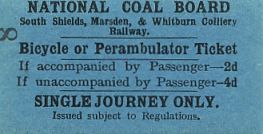
Ticket No. 31 - A single journey Bicycle or Perambulator ticket issued post 1947 in the name of the National Coal Board (N.C.B.). The reverse is blank.
With nationalisation came modernisation at the colliery and in 1948 Whitburn saw the arrival of underground locomotives. Prior to their arrival a man would travel 3 ¼ miles by train from South Shields and then have to walk 7 miles from the shaft bottom to the coalface out under the North Sea.
In 1953 the N.C.B. announced plans to upgrade the colliery at Westoe. The first part of the plan was to build a new £1million coal washer. The washery was designed to handle 500 tons of coal an hour, this could cope with the entire production of the collieries in the area and so coal was brought in from other areas. This coal was referred to locally as "foreign" coal. The coal was delivered by British Railways to an exchange siding and brought though Westoe Lane station by new electric locomotives. Westoe Lane had always been a bottleneck and the influx of foreign coal meant a huge increase in the number of train movements, so to provide an unobstructed path to the washery it was decided to withdraw the passenger service. The service lumbered on during 1953, interestingly with third class tickets still being sold at 1888 prices. The final timetable did not have any departures for Saturday or Sunday and the weekday departures consisted of 12 trains in each direction. The service was replaced by buses to take the miners to Whitburn colliery on Monday 14th November but for some reason the rail service continued to operate for one more week. It was reported that the last scheduled train ran on 22nd November departing Westoe Lane at 9.58pm and it was probably empty.
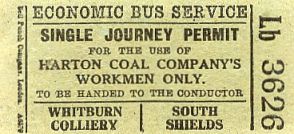
Ticket No. 32 - Workman's single journey travel permit from South Shields to Whitburn Colliery. The reverse of these permits, which was only valid for Harton Coal Company workmen, states that they were to be handed to the conductor of the said bus service who was then to issue each permit holder with a valid ticket for the single journey stated and that the conductor was to punch the replacement ticket in the presence of each workman. It is not known how these special bus services operated or if they were purely emergency services organised in times of major maintenance on the SS, M&WCR. It is presumed that the Economic Bus Service return the Travel Permits to the H.C.C. for re-imbursement.
In 1954 the opening of the washery at Westoe as well as the closure of the line to passenger traffic meant that the increased number of coal train movements could be handled far more efficiently. The track at Westoe Lane station, which once saw the departure of the 'Rattler' was electrified to help ease congestion. All of the coal from Whitburn Colliery was now moved by rail to Westoe for washing and grading.
Also by 1954, Whitburn Colliery was producing vast amounts of coal and had become the most productive of the Harton group of pits, but this was to change in 1957 when the N.C.B. announced a major investment program that was to turn Westoe into what was referred to as a 'super pit'.
The railway and Whitburn Colliery laboured on into the 1960's, but during 1965 the N.C.B. sold off the two Marsden quarries that soon brought an end to the rail movement of limestone, as lorries took over deliveries immediately. Also during 1965 the N.C.B. brought in three new diesel locomotives to replace all the steam engines which had over the years given sterling service. These diesels were put to work 24 hours a day, 7days a week during a seaman's strike in 1966, which closed the Harton Staiths for quite a while. Whilst the strike was taking place it was decided to use Whitburn colliery to stockpile all of the coal produced by the Harton pits. This lead to intense activity on the railway the like of which was never to be seen again.
By 1967 rumours were starting to be spread that both Harton and Whitburn collieries were to be closed as part of a rationalisation plan for the coal industry. In January 1968 the N.C.B. told the miners the weekly tonnage of coal that had to be produced to keep the pit open, in May this total was exceeded and two weeks later the pit was closed!
The last shift was worked on the 7th June 1968 and the pit and railway officially abandoned on the 8th June. There were in fact a few more loads of coal moved up the line to Westoe and the last passenger train to use the line was a hastily arranged rail enthusiasts' special which ran on 7th September 1968, and of course other trains were used later on track clearing operations.
The demolition of Whitburn colliery began in October 1968 and the lifting of the majority of the railway began at the same time, thus confining both to the history books. A small ½ mile section of the railway survived, this was situated just south of Westoe colliery and lasted until the closure of the pit in 1993. With Westoe colliery's demolition in 1994 the last remaining part of the Marsden Railway was lifted, after over 100 years of use.
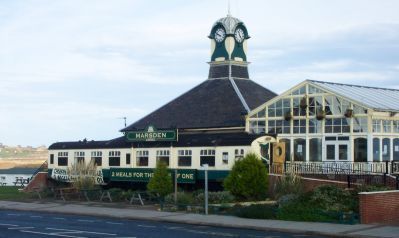
One of the very few reminders left of the South Shields, Marsden & Whitburn Colliery Railway - The "Marsden Rattler" public house on the sea front at South Shields close to the old line terminus.
References & Further Reading:
Hatcher. G. (2002) The South Shields, Marsden and Whitburn Colliery Railway. Published by The Oakwood Press.
Transcription of the notes prepared by William J. Skillern for the Stephenson and Manchester Locomotive Society's Railtour of 7th September 1968, with some additional notes by John M. Lloyd.
The South Shields, Marsden & Whitburn Colliery Railway. William J. Skillern, The Railway Magazine, October 1953.
Reproduced by kind permission of the author : John Whysall. © November 2003